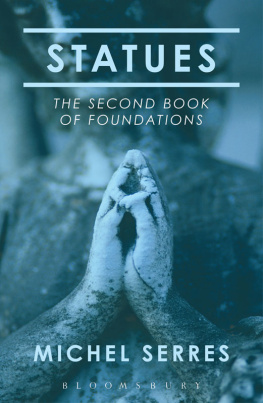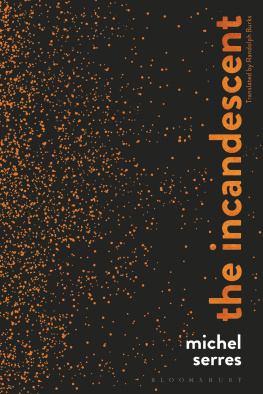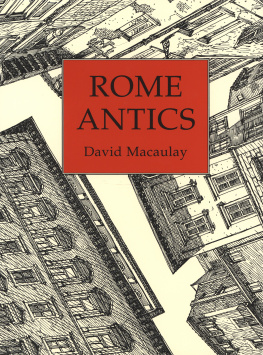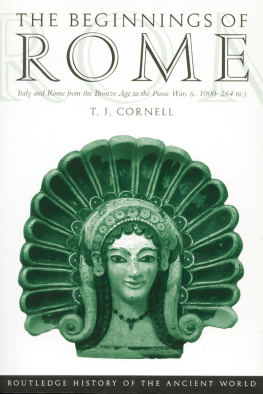Rome
Also available from Bloomsbury
Statues , Michel Serres (translated by Randolph Burks)
Times of Crisis , Michel Serres (translated by Anne-Marie Feenberg-Dibon)
The Five Senses , Michel Serres (translated by Margaret Sankey and Peter Cowley)
Rome
The First Book of Foundations
Michel Serres
(translated by Randolph Burks)
Bloomsbury Academic
An imprint of Bloomsbury Publishing Plc
With the present book and, if my life isnt too hard, with some
others to follow, I express my gratitude to the community of
historians that welcomed me thirteen years ago when the
pressure group then in power expelled me from my former
paradise: philosophy. Thereby making my life hard.
With this same book, I thank Ren Girard, who, in similar
circumstances, welcomed me, a quasi-refugee, into the
hospitable America and who then taught me the true ideas
developed here.
Contents
The shaking that grips me upon starting a book on history isnt from fear; Im not afraid. And yet, here, terror reigns, murder, blood and tears, constant iniquity. I know that we never encounter any social system thats just; Ive rarely known, living or dead, any powerful man who was good. The shaking gripping me is not from fear; it is, if I may, from logic. It would be an exercise in futility if a philosophy formed from its instauration by the rigorous and precise concepts of the sciences of the object brought its practices into the unstable cloud of time. It either wouldnt understand, or it would be formed with shaky outlines. History is fuzzy and vague, but it was precisely the sciences of the object that prepared me to think this shakiness with exactitude. So here I am on the terrain of terror, for the first time, finally ready, despite my anxiety. This century we have new tools. Here they are.
Michel Serres
Sowing: geographical sites arent subject to simple reasons. Islands, ports or coves, straits, coastal outlines, plains, valleys and relief are distributed without any apparent order. The Mediterranean seacoast is capricious; its recesses cant be predicted.
The ancient cities are sown sporadically along said coast (Tyre, Ephesus, Agrigentum, Pergamon, Alexandria) and not far from the coast (Troy or Sparta) in a long and not very wide band, according to geographical circumstance. At the outset, Ill give myself the sowing of the ancient cities in space and, for the moment, outside time. Ill assume ignorance at this moment of how things are with time. Antiquity shows us a set of cities thats fairly dense by the sea, disordered like the Sporades in the sea, and sparser as one gets farther away from the sea. Hittite or Semite cities, Etruscan or Ionian, Sicilian, Greek, Massiliote cities. The ancient city was for a long time a concept; it was a type and even an ideal; its time to see it simply as a set.
Lets take a colony of termites, whose apparently Brownian motion at this moment will seem, long after, to have been ordered for the construction of a termite hill. This latter is a gigantic work in relation to the size of the individuals; its a fairly regular work in relation to the disorder of their comings and goings.
Each termite, or almost, is carrying a ball of clay, lets say. It doesnt take it anywhere; it puts it down in the space considered. Said space is nothing but the set of the placed balls. The termites withdraw and return to the clay pit. The balls placed here are distributed sporadically. They form a sowing.
The ancient cities are thus sown in or by the geography.
Their set is a non-standardized multiplicity. Each city is very different, and we dont know very well where this set ends. Near the Parthians, the Germans, Mauritania, Dacia? Its of no matter.
It happens, it can happen, through some circumstance of some kind that two termites might put their clay balls down in the same vicinity, perhaps in the same place. This has an effect; one ball looks to be two times taller and bigger. The same circumstance can even happen, even more rarely, to three termites or four.
The termites leave and come back loaded with new clay balls. They dont take them anywhere; they put them down. They are going to place them, by preference, on the first taller, bigger ball. The effect of the latter is one of attraction.
Our reason dreams of reconciling Democritus and Newton, of weaving together stochastic sowing and the law of harmony, dark chance and clear necessity, order and dissemination.
The second wave of termites puts their balls down just anywhere, but a fairly reasonable number of them form double, triple and sometimes quadruple balls. The set is now made up of monads, but a subset of dyads appears, as well as a subset of triads, even less powerful, and so on.
The waves of termites never stop. They go in search of balls and come back to deposit them. The density of clay grows in this expanse; the probability of the appearance of double, triple and quadruple balls grows as well. The piles grow all the more by virtue of the fact that they are already voluminous: the attraction effect. As the waves bring in what they carry, large centres, like poles, form; sub-centres form, an entire constellation of dwarf, medium and supergiant balls.
The model, I repeat, is Democritean. It forms by set and by elements. Each individual, the carrying termite or rolled ball, seems to follow its own whim, is subject to crashes, encounters and in relation to the global work of the termite hill seems to fluctuate randomly. Local Brownian motion in a world subject to some strong global law. But the model, again, is quasi-Newtonian since a large ball seems to attract the carriers and has more chance of growing than a more exiguous ball. The model, in total, is a cloud, in the sense I have given this word in the past, but this cloud sown in a space has a tendency to organize itself under the impetus of said Newtonian law. Like mayonnaise when it sets.
It can therefore happen that at a given moment a giant ball might attract a set of already large balls and that in total, this well might suddenly suck in all the workers: then the termite hill begins.
Im sure that here and there, around, a few individuals will always continue to deposit balls on the ground while the Tower of Babel is being raised. These termites are the guardians of the possible. They sow the time of hope while laws and the repetitive are being solidified by the crystal next to them.
The ancient cities are disseminated, non-standardized, along the shores of the Mediterranean Sea. One sole law: they fight each other. One sole law of order: hatred. One sole rule of attraction: slaughter. Destruction, absorption. Rome levels Alba; it brings an entire population inside its walls. It also knows how to put the totality of the defeated to the sword. Geography orders the sowing; its the Democritean order, the cloud that never stops, that has perhaps never begun, that I have to hope will never stop. Secondly, there is only need for one law, that law without origin, the hatred which never stops, always there, unforgettable, perhaps alas ineradicable. Rome, therefore, destroys Alba and grows.
One ball widens; this was called war or conquest, simple slaughter, collective butchery, sanctioned, sanctified by the texts of history; the ball absorbs its neighbour, and these enlargements fluctuate across time. Here is the cloud of small cities, and the subcloud that manufactures an empire, and the subcloud as well of great confederations, with quick or long lives; notice the parallel with what I just called dyad, triad, tetrade and so on as long as you please, pentade. The attraction, the power varies with the volume. This power is indeed a capacity to attract, to absorb, yes, to subsume the multiple. So the earth known to us is a constellated sky of balls dwarf, medium, large, supergiant within a tenuous scattering of very small towns. The fluctuations of this field create the time of history. One might say the history of the heavens.
Next page










